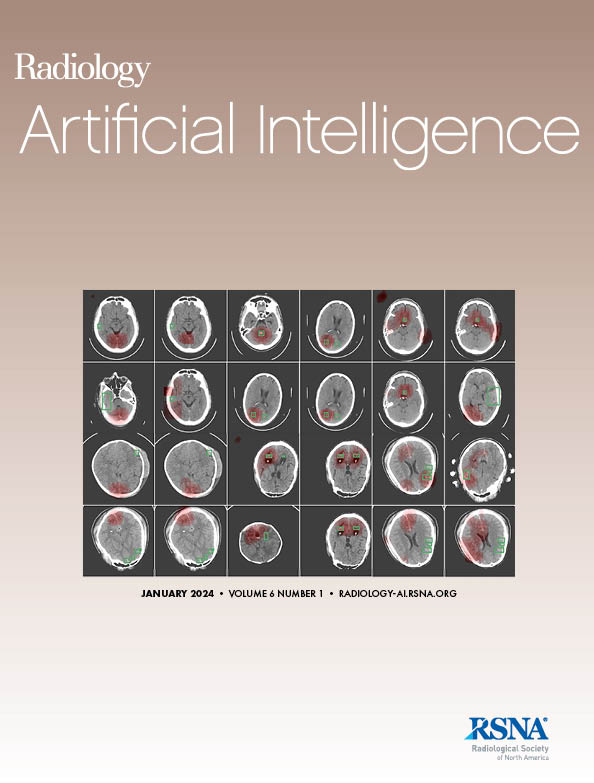Francesco Santini, Jakob Wasserthal, Abramo Agosti, Xeni Deligianni, Kevin R Keene, Hermien E Kan, Stefan Sommer, Fengdan Wang, Claudia Weidensteiner, Giulia Manco, Matteo Paoletti, Valentina Mazzoli, Arjun Desai, Anna Pichiecchio
求助PDF
{"title":"深度解剖联合网络(Dafne):一个开放的客户端-服务器框架,用于持续协作改进基于深度学习的医学图像分割。","authors":"Francesco Santini, Jakob Wasserthal, Abramo Agosti, Xeni Deligianni, Kevin R Keene, Hermien E Kan, Stefan Sommer, Fengdan Wang, Claudia Weidensteiner, Giulia Manco, Matteo Paoletti, Valentina Mazzoli, Arjun Desai, Anna Pichiecchio","doi":"10.1148/ryai.240097","DOIUrl":null,"url":null,"abstract":"<p><p>Purpose To present and evaluate Dafne (deep anatomical federated network), a freely available decentralized, collaborative deep learning system for the semantic segmentation of radiologic images through federated incremental learning. Materials and Methods Dafne is free software with a client-server architecture. The client side is an advanced user interface that applies the deep learning models stored on the server to the user's data and allows the user to check and refine the prediction. Incremental learning is then performed on the client's side and sent back to the server, where it is integrated into the root model. Dafne was evaluated locally by assessing the performance gain across model generations on 38 MRI datasets of the lower legs and through the analysis of real-world usage statistics (639 use cases). Results Dafne demonstrated a statistical improvement in the accuracy of semantic segmentation over time (average increase of the Dice similarity coefficient by 0.007 points per generation on the local validation set, <i>P</i> < .001). Qualitatively, the models showed enhanced performance on various radiologic image types, including those not present in the initial training sets, indicating good model generalizability. Conclusion Dafne showed improvement in segmentation quality over time, demonstrating potential for learning and generalization. <b>Keywords:</b> Segmentation, Muscular, Open Client-Server Framework <i>Supplemental material is available for this article.</i> © RSNA, 2025.</p>","PeriodicalId":29787,"journal":{"name":"Radiology-Artificial Intelligence","volume":" ","pages":"e240097"},"PeriodicalIF":13.2000,"publicationDate":"2025-05-01","publicationTypes":"Journal Article","fieldsOfStudy":null,"isOpenAccess":false,"openAccessPdf":"","citationCount":"0","resultStr":"{\"title\":\"Deep Anatomical Federated Network (Dafne): An Open Client-Server Framework for Continuous, Collaborative Improvement of Deep Learning-based Medical Image Segmentation.\",\"authors\":\"Francesco Santini, Jakob Wasserthal, Abramo Agosti, Xeni Deligianni, Kevin R Keene, Hermien E Kan, Stefan Sommer, Fengdan Wang, Claudia Weidensteiner, Giulia Manco, Matteo Paoletti, Valentina Mazzoli, Arjun Desai, Anna Pichiecchio\",\"doi\":\"10.1148/ryai.240097\",\"DOIUrl\":null,\"url\":null,\"abstract\":\"<p><p>Purpose To present and evaluate Dafne (deep anatomical federated network), a freely available decentralized, collaborative deep learning system for the semantic segmentation of radiologic images through federated incremental learning. Materials and Methods Dafne is free software with a client-server architecture. The client side is an advanced user interface that applies the deep learning models stored on the server to the user's data and allows the user to check and refine the prediction. Incremental learning is then performed on the client's side and sent back to the server, where it is integrated into the root model. Dafne was evaluated locally by assessing the performance gain across model generations on 38 MRI datasets of the lower legs and through the analysis of real-world usage statistics (639 use cases). Results Dafne demonstrated a statistical improvement in the accuracy of semantic segmentation over time (average increase of the Dice similarity coefficient by 0.007 points per generation on the local validation set, <i>P</i> < .001). Qualitatively, the models showed enhanced performance on various radiologic image types, including those not present in the initial training sets, indicating good model generalizability. Conclusion Dafne showed improvement in segmentation quality over time, demonstrating potential for learning and generalization. <b>Keywords:</b> Segmentation, Muscular, Open Client-Server Framework <i>Supplemental material is available for this article.</i> © RSNA, 2025.</p>\",\"PeriodicalId\":29787,\"journal\":{\"name\":\"Radiology-Artificial Intelligence\",\"volume\":\" \",\"pages\":\"e240097\"},\"PeriodicalIF\":13.2000,\"publicationDate\":\"2025-05-01\",\"publicationTypes\":\"Journal Article\",\"fieldsOfStudy\":null,\"isOpenAccess\":false,\"openAccessPdf\":\"\",\"citationCount\":\"0\",\"resultStr\":null,\"platform\":\"Semanticscholar\",\"paperid\":null,\"PeriodicalName\":\"Radiology-Artificial Intelligence\",\"FirstCategoryId\":\"1085\",\"ListUrlMain\":\"https://doi.org/10.1148/ryai.240097\",\"RegionNum\":0,\"RegionCategory\":null,\"ArticlePicture\":[],\"TitleCN\":null,\"AbstractTextCN\":null,\"PMCID\":null,\"EPubDate\":\"\",\"PubModel\":\"\",\"JCR\":\"Q1\",\"JCRName\":\"COMPUTER SCIENCE, ARTIFICIAL INTELLIGENCE\",\"Score\":null,\"Total\":0}","platform":"Semanticscholar","paperid":null,"PeriodicalName":"Radiology-Artificial Intelligence","FirstCategoryId":"1085","ListUrlMain":"https://doi.org/10.1148/ryai.240097","RegionNum":0,"RegionCategory":null,"ArticlePicture":[],"TitleCN":null,"AbstractTextCN":null,"PMCID":null,"EPubDate":"","PubModel":"","JCR":"Q1","JCRName":"COMPUTER SCIENCE, ARTIFICIAL INTELLIGENCE","Score":null,"Total":0}
引用次数: 0
引用
批量引用

 求助内容:
求助内容: 应助结果提醒方式:
应助结果提醒方式:


